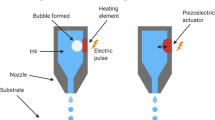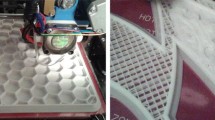Abstract
Three-dimensional (3D) printing has recently erupted into the medical arena due to decreased costs and increased availability of printers and software tools. Due to lack of detailed information in the medical literature on the methods for 3D printing, we have reviewed the medical and engineering literature on the various methods for 3D printing and compiled them into a practical “how to” format, thereby enabling the novice to start 3D printing with very limited funds. We describe (1) background knowledge, (2) imaging parameters, (3) software, (4) hardware, (5) post-processing, and (6) financial aspects required to cost-effectively reproduce a patient’s disease ex vivo so that the patient, engineer and surgeon may hold the anatomy and associated pathology in their hands.

















Similar content being viewed by others
References
Kumar S et al. Reinforcement of stereolithographic resins for rapid prototyping with cellulose nanocrystals. ACS Appl Mater Interfaces. 2012;4(10):5399–407. doi:10.1021/am301321v.
Kumar S, Kruth JP. Composites by rapid prototyping technology. Mater Des. 2010;31(2):850–6.
Picariello P. ASTM international committee F42 on additive manufacturing technologies. 2014. Available from: http://www.astm.org/Standards/F2792.htm. Accessed October 2015
Waisman M et al. Intraosseous regional anesthesia as an alternative to intravenous regional anesthesia. J Trauma. 1995;39(6):1153–6.
Bartolo P. Stereolithography: materials, processes and application. New York: Springer; 2011.
Cohen A et al. Mandibular reconstruction using stereolithographic 3-dimensional printing modeling technology. Oral Surg Oral Med Oral Pathol Oral Radiol Endod. 2009;108(5):661–6.
Campbell T, Williams C, Ivanova O, Garrett B. Could 3D printing change the world? In: Strategic foresight initiative, Washington, DC: Atlantic Council. October 2011.
Rengier F et al. 3D printing based on imaging data: review of medical applications. Int J Comput Assist Radiol Surg. 2010;5(4):335–41. doi:10.1007/s11548-010-0476-x.
Kruth JP, Leu MC, Nakagawa T. Progress in additive manufacturing and rapid prototyping. CIRP Ann Manuf Technol. 1998;47(2):525–40.
Berman B. 3-D printing: the new industrial revolution. Bus Horiz. 2012;55(2):155–62.
Bak D. Rapid prototyping or rapid production? 3D printing processes move industry towards latter. Assem Autom. 2003;23:340–5.
Lipson H et al. 3-D printing the history of mechanisms. J Mech Des. 2005;127(5):1029.
Price TR. A brief history Of 3D Printing. 2011. http://individual.troweprice.com/staticFiles/Retail/Shared/PDFs/3D_Printing_Infographic_FINAL.pdf. Accessed October 2015
Kim MS et al. Rapid prototyping: a new tool in understanding and treating structural heart disease. Circulation. 2008;117(18):2388–94.
Evans B. Practical 3D printers. New York: Springer; 2012.
Silva DN et al. Dimensional error in selective laser sintering and 3D-printing of models for craniomaxillary anatomy reconstruction. J Craniomaxillofac Surg. 2008;36(8):443–9.
Markert M, Weber S, Lueth TC. A beating heart model 3D printed from specific patient data. Conf Proc IEEE Eng Med Biol Soc. 2007;2007:4472–5.
Mironov V et al. Organ printing: computer-aided jet-based 3D tissue engineering. Trends Biotechnol. 2003;21(4):157–61.
Lewis M, Reid K, Toms AP. Reducing the effects of metal artefact using high keV monoenergetic reconstruction of dual energy CT (DECT) in hip replacements. Skelet Radiol. 2013;42(2):275–82.
Meinel FG et al. Metal artifact reduction by dual-energy computed tomography using energetic extrapolation: a systematically optimized protocol. Investig Radiol. 2012;47(7):406–14. doi:10.1097/RLI.0b013e31824c86a3.
Ebert LC, Thali MJ, Ross S. Getting in touch: 3D printing in forensic imaging. Forensic Sci Int. 2011;211(1-3):e1–6.
Kalogerakis E, Hertzmann A, Singh K. Learning 3D mesh segmentation and labeling. ACM Trans Graph. 2010;29(4):1.
Rosset A, Spadola L, Ratib O. OsiriX: an open-source software for navigating in multidimensional DICOM images. J Digit Imaging. 2004;17(3):205–16.
Sheffer A, Praun E, Rose K. Mesh parameterization methods and their applications. Found Trends Comput Graph Vis. 2006;2(2):105–71.
Floater MS, Hormann K. Surface parameterization: a tutorial and survey. In: Farin G, Hans-Christian H, Hoffman D, Johnson C, Polthier K, Rumpf M, editors. Advances in multiresolution for geometric modelling. New York: Springer; 2005.
Cignoni P, et al. MeshLab: an open-source mesh processing tool. In: Eurographics Italian Chapter Conference. 2008. Geneva: The Eurographics Association.
Hess R. The essential Blender: guide to 3D creation with the open source suite Blender. 2007. San Francisco: No Starch Press.
Augustine KE, et al. Plan to procedure: combining 3D templating with rapid prototyping to enhance pedicle screw placement. In: SPIE Medical Imaging. 2010. Bellingham, WA: International Society for Optics and Photonics.
Owen BD et al. Rapid prototype patient-specific drill template for cervical pedicle screw placement. Comput Aided Surg. 2007;12(5):303–8.
Parthasarathy J. 3D modeling, custom implants and its future perspectives in craniofacial surgery. Ann Maxillofac Surg. 2014;4(1):9.
Zein I et al. Fused deposition modeling of novel scaffold architectures for tissue engineering applications. Biomaterials. 2002;23(4):1169–85.
Sood AK, Ohdar R, Mahapatra S. Parametric appraisal of mechanical property of fused deposition modelling processed parts. Mater Des. 2010;31(1):287–95.
Ilievski F et al. Soft robotics for chemists. Angew Chem. 2011;123(8):1930–5.
Giordano RA et al. Mechanical properties of dense polylactic acid structures fabricated by three-dimensional printing. J Biomater Sci Polym Ed. 1997;8(1):63–75.
Hutmacher DW, Sittinger M, Risbud MV. Scaffold-based tissue engineering: rationale for computer-aided design and solid free-form fabrication systems. Trends Biotechnol. 2004;22(7):354–62.
Butscher A et al. Structural and material approaches to bone tissue engineering in powder-based three-dimensional printing. Acta Biomater. 2011;7(3):907–20.
Acknowledgements
We would like to thank Marissa Empey, our graphic artist, for doing figures 6 to 11.
Author information
Authors and Affiliations
Corresponding author
Ethics declarations
Conflict of interest
The authors declare that they have no conflict of interest.
Rights and permissions
About this article
Cite this article
Friedman, T., Michalski, M., Goodman, T.R. et al. 3D printing from diagnostic images: a radiologist’s primer with an emphasis on musculoskeletal imaging—putting the 3D printing of pathology into the hands of every physician. Skeletal Radiol 45, 307–321 (2016). https://doi.org/10.1007/s00256-015-2282-6
Received:
Revised:
Accepted:
Published:
Issue Date:
DOI: https://doi.org/10.1007/s00256-015-2282-6




